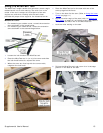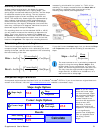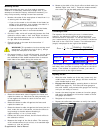
20 Kapex KS120 Miter Saw
Compound Miter Cuts
Compound miter cuts are where the saw is both in a miter
position and a bevel position at the same time. There are
several applications for compound miter cuts, but cutting
crown moulding and sloped miters are common examples.
The example below shows a very simple birdfeeder roof.
The greatest challenge with compound miters is
determining the proper saw settings to achieve the desired
miter angle. These saw settings can be found in look-up
tables for standard mouldings, but for non-standard
angles, determining the proper saw settings requires
mathematical calculation.
Note that there are several methods for
accurately cutting crown moulding depending on
the circumstances. Make sure to review the
methods described in the applicable section on
page 21.
Calculating compound miter settings requires two
parameters from the desired joint: the corner angle and
the slope.
Corner Angle
The corner angle is the angle between the two pieces,
when viewed looking straight down on the joint. The
corner angle is relatively easy to determine, but it is also
the value that can cause the greatest amount of confusion
for many woodworkers. That’s because most woodworkers
view angles differently than a mathematician will. A
woodworker typically considers both inside and outside
corners as 90 degrees (with a 45 degree miter) even
though a mathematician would make the distinction that
one corner is 90 degrees and the other is 270 degrees. To
be consistent with miter saw settings, the corner angle is
measured from a straight line between the two pieces, as
shown above.
Slope
The Slope angle is the angle that each piece makes with
respect to the base of the corner, such as the ceiling or
floor in the examples provided here. For a roof-like
structure, this would be the pitch of the roof.
For crown moulding, this would be the
compliment of the “Spring Angle” of the
moulding. Common spring angles for
mouldings are 38/52 and 45/45.
Determining the Corner Angle of Polygons
The corner angle for standard polygons is
shown in the table on page 18.
Using the MiterFast Tool to Find a Corner Angle
For non-standard corner angles, such as a
room that is slightly out of square, the
MiterFast tool can be used to determine the
corner angle. To use the MiterFast tool to measure
the corner angle, follow the “Using the MiterFast Tool
”
procedure on page 15, but instead of making the cut,
record the saw’s miter setting angle. This angle is ½ the
corner angle, so multiplying by 2 will give you the corner
angle. (The compound angle calculator on page 21 also
has an option for letting you enter this angle directly
without needing to double it.)
Determining the Slope of a Pyramid (Polyhedron)
A polyhedron is a pyramid that can have any number of
sides. The easiest method for determining the slope of the
polyhedron is by measuring the Drop and Projection of
one face. These are the distances from the center-to-the-
edge, and the base-to-the-point of the pyramid. Note that
with a polyhedron with an odd number of sides, the center
is found by drawing bisecting lines as shown in the image
below.


















